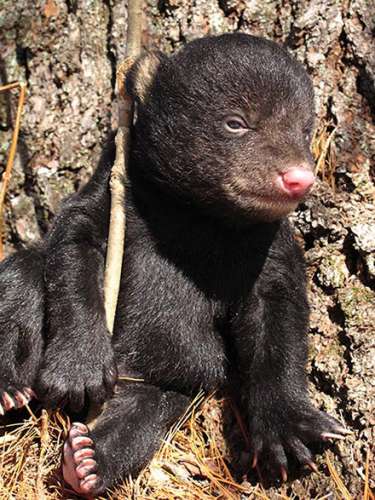When snow drifts linger into late April and freezing rain challenges new blossoms, mother bears and their infant cubs seek out wetland edge habitats. Seepage areas and vernal pools, as well as bogs, marshes, and beaver flowages offer concentrated foods, which are largely unavailable within the cold woods. In our region, lactating sows eagerly consume the new stems, roots, swelling buds, catkins, and new leaves of a variety of tree species, including aspen, willow, American beech, and eastern hophornbeam. They’ll eat the roots, stems, and new leaves and flowers of water parsnip, cattails, swamp thistle, water plantain, pickerelweed, sweet cicely, and water arum, and various spring flowers, as well, including wild sarsaparilla, yellow dandelions, hawkweed, blue violets, golden saxifrage, clovers, lilies, jack-in-the-pulpit, and skunk cabbage.
Aside from tracks in the mud, how can we determine if a sow with cubs has used a given wetland? I look for babysitter trees, usually large hemlocks or white pines. It’s long been known that bears cubs will climb large trees to escape predators, but I discovered nearly 40 years ago that certain trees in wetland habitats are used every year by a female with her new cubs. Mother hides her cubs high in the concealing foliage of these large conifers while she forages throughout the wetland nearby. When she returns to retrieve and nurse her young, she keeps them warm in a “daybed” – a goose-nest-shaped depression that is often lined with grasses, pine needles, and other soft materials. Beside a daybed, look for greenish-black scat, which appears different from the fruit and nut-filled feces that we find later in summer and fall. Some scat may be filled with the remains of ants and other invertebrates. Protein-rich insects, including ants, woodborers, beetles, caterpillars, and even snow fleas contribute to a bear’s diet as summer nears. Search for rotten logs and stumps that have been torn apart by a bear seeking these valuable foods.
Scent marking leaves the most enduring sign. See if you can find broken, bent over, bitten saplings with black bear hairs stuck within the splintered wood or sap. Such trees may have been straddle-marked and rubbed by the sow seeking to communicate her occupancy of the habitat. Other saplings, especially willow, aspen, beech, and eastern hophornbeam, may appear marked as well, but claw marks and broken tops on these species are evidence of a bear’s feeding.
What about the hazards of searching for bear sign in wetlands during spring? Frankly, we are the dangerous ones out there! Our visitations, however well intentioned, frighten anxious mothers and disrupt their delicate energy budgets at a time when the bears can least afford it. Wait to look until July, when bear families don’t need the concentrated spring foods of wetlands anymore. By then their foraging takes them throughout forest and glade, wherever summer’s cornucopia of fruit, flowers, and nuts may be enjoyed.


